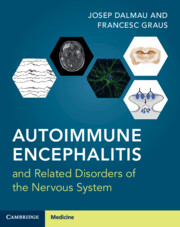Book contents
- Autoimmune Encephalitis and Related Disorders of the Nervous System
- Autoimmune Encephalitis and Related Disorders of the Nervous System
- Copyright page
- Dedication
- Contents
- Clinical Vignettes
- Videos
- Preface
- Abbreviations
- Section 1 Overview
- Section 2 Antibodies and Antigens
- Section 3 Specific Syndromes and Diseases
- Section 4 Autoimmunity in Neurological and Psychiatric Diseases
- Chapter 19 Autoimmune Psychosis
- Chapter 20 Psychiatric Manifestations of Autoimmune Encephalitis
- Chapter 21 Abnormal Movements in Neurological Autoimmune Disorders
- Chapter 22 Sleep and Autoimmunity
- Chapter 23 Immunity, Inflammation, and Epilepsy
- Chapter 24 Autoimmune Dementia: A Useful Term?
- Chapter 25 Frequently Asked Questions on Autoimmune Encephalitis and Related Disorders
- Index
- References
Chapter 19 - Autoimmune Psychosis
from Section 4 - Autoimmunity in Neurological and Psychiatric Diseases
Published online by Cambridge University Press: 27 January 2022
- Autoimmune Encephalitis and Related Disorders of the Nervous System
- Autoimmune Encephalitis and Related Disorders of the Nervous System
- Copyright page
- Dedication
- Contents
- Clinical Vignettes
- Videos
- Preface
- Abbreviations
- Section 1 Overview
- Section 2 Antibodies and Antigens
- Section 3 Specific Syndromes and Diseases
- Section 4 Autoimmunity in Neurological and Psychiatric Diseases
- Chapter 19 Autoimmune Psychosis
- Chapter 20 Psychiatric Manifestations of Autoimmune Encephalitis
- Chapter 21 Abnormal Movements in Neurological Autoimmune Disorders
- Chapter 22 Sleep and Autoimmunity
- Chapter 23 Immunity, Inflammation, and Epilepsy
- Chapter 24 Autoimmune Dementia: A Useful Term?
- Chapter 25 Frequently Asked Questions on Autoimmune Encephalitis and Related Disorders
- Index
- References
Summary
In this chapter we critically trace the concept of autoimmune psychosis, and review several well-defined autoimmune diseases that can manifest with psychosis. After the discovery of anti-NMDAR encephalitis, several studies suggested that NMDAR antibodies could occur in patients with psychosis caused by primary psychiatric diseases. This led to a generalized NMDAR antibody testing without much consideration for validation of results, the use of appropriate controls, or whether the antibodies were also present in CSF (most studies only partially examined serum). Two consequences of this uncontrolled testing were: (1) the wide range in prevalence of serum NMDAR antibodies (from 0% to 20% in patients with many different diseases, including healthy controls) among different laboratories often using the same commercial diagnostic test; and (2) the lack of clinical significance of the findings. These inconclusive studies refocused the attention of investigators to search for a specific psychiatric phenotype of anti-NMDAR encephalitis, but no specific phenotype could be identified. However, there are several important clinical clues that suggest when a first episode of psychosis is autoimmune, and we provide a diagnostic algorithm to identify these cases. Aside from anti-NMDAR encephalitis, psychiatric manifestations are prominent in three other disorders: paediatric autoimmune neuropsychiatric disorders associated with streptococcal infection (PANDAS), Hashimoto encephalopathy, and neuropsychiatric manifestations of systemic lupus erythematosus (SLE). In the first two disorders the autoimmune basis is unclear and no pathogenic antibodies have been identified. In SLE, none of the antibodies reported to be associated with neuropsychiatric manifestations has shown neuropsychiatric symptom specificity. Moreover, none of the SLE antibodies has shown properties similar to those of neuronal surface antibodies related to autoimmune encephalitis, which associate with specific syndromes, alter neuronal function by direct interaction with the cell surface target, and cause symptoms in animal models, including psychotic-like behaviour.
Keywords
- Type
- Chapter
- Information
- Publisher: Cambridge University PressPrint publication year: 2022
References
- 1
- Cited by



